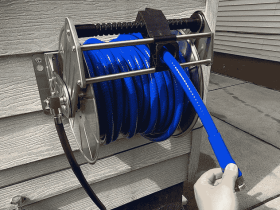Nothing keeps a homeowner on their toes like rain. Untamed water can destabilize the foundation and disfigure the interior and exterior finishes, making it an eyesore. Properly installed gutter systems can solve these issues. This article offers ten innovative design ideas for your gutter drainage systems.
1. Gutter guards
You must keep your gutters free from leaves and debris. If these accumulate inside the gutters and downspouts, the water flow will be impeded, letting it spill over into undesignated areas and causing damage. Install leaf blockers, which usually come in types like mesh, screen, and helmet. Mesh and screen guards filter fine debris, while helmet guards deflect leaves to allow water to flow seamlessly. For colder climates, you’d want to install heated gutter guards to prevent ice dams.
2. Downspout sizing
The downspout needs to be of sufficient capacity to drain water effectively. Its diameter should match the intensity of the rainfall in your area and the roof size. An experienced local gutter company can help you with these engineering design calculations. Under-sizing the downspout can cause overflows while oversizing will increase the costs unnecessarily. Besides traditional downspouts, you can choose alternatives like rain chains or rain barrels.
3. Destination determinations
You must direct the harvested water to a designated drainage area. Allowing it to pool around the house will cause structural damage to the foundation. Consider constructing French drains to direct water away from your house. These are typically filled with gravel, with a perforated pipe at the core. At the end of the drainage channels, plant a rain garden. This takes the form of a shallow depression with native plants to support infiltration.
4. Material matters
Metal gutters are your go-to option if your primary concern is durability and affordability. Galvanized steel gutters have high strength, lasting between 15 and 20 years. Copper gutters can’t be equaled in terms of elegance. Moreover, exposure to the elements deposits a vibrant patina layer on its surface, making it even more appealing. Aluminum is lightweight and rust-resistant; thus, it is another valid option. Vinyl and plastic gutters are also gaining traction among homeowners because of their cost-effectiveness and ease of installation.
5. Sump pumps
About 98% of homes experience some form of water damage in the basement. Thus, you may want to install sump pumps in the lowest part of your basement or crawlspace to curb flooding. They turn on automatically when water accumulates to a certain level. Regularly inspect the pump and clean the pit for optimal performance. You won’t worry about heavy rains making the rooms down there uninhabitable.
6. Smart drainage
Technology has brought rise to smart gutter systems equipped with sensors. Their aim is to analyze rainfall levels and widen or narrow the gutter level for seamless drainage. Automation optimizes drainage performance without the need for manual intervention. They also notify you about blockages, and you can quickly spring into action before the issues escalate to damaging proportions. Alerts are delivered to your smartphone, enhancing convenience.
7. Regular maintenance
It’s important to clean your gutters regularly. Remove leaves and debris stuck in the channels and downspouts. It’s a simple task but goes a long way to ensuring smooth water flow. It also boosts the longevity of the system, as accumulated debris can accelerate wear and tear. If your compound doesn’t have many trees, cleaning your gutters once or twice annually should suffice. But it’s wise to monitor their state all year round and act promptly when you notice dirt stockpiling.
8. DIY vs. Professional
You can independently handle some easy gutter maintenance, including cleaning out debris and leaves, inspecting for damage, and realigning downspouts. Get the right tools and enforce the necessary safety measures. But sometimes, calling professionals is advisable. Complex tasks like fresh gutter installation, repairing extensive damage, and redesigning the system require expertise. Working with professionals guarantees the longevity of the installations.
9. Color coordination
Gutter color is an essential element of curb appeal. Select a shade that complements your home’s exterior finish. You can make your gutter blend with the siding or contrast it. For instance, if your home’s siding is light gray, choose gutters in a slightly different shade of gray for a seamless blend. In contrast, you could choose dark blue gutters for a white home.
10. Eco-conscious options
Sustainability is a critical consideration in today’s world. In the realm of gutter drainage systems, you can use rain barrels or rainwater tanks to collect roof runoff instead of letting the water drain away. The collected water can help in the garden or be used for house chores. Another eco-friendly idea is using permeable pavers for your driveway. These allow water to seep through into the ground, replenishing local aquifers and mitigating erosion.
Conclusion
Gutter drainage systems are essential in preventing water damage. Each idea highlighted above can transform rainwater from a challenge into an asset. Your winning point is consulting professionals on gutter issues beyond your capacity. With the right installations, you can have peace of mind, no matter how much it rains.











Leave a Review